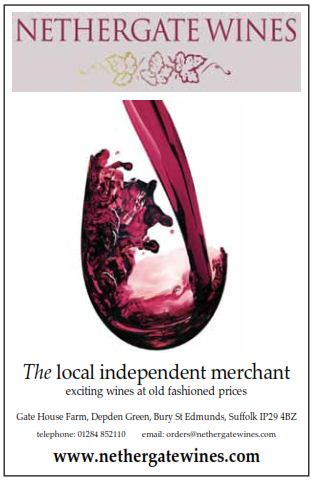TEA AND THE TEA CADDY A BRIEF STUDY OF THE EARLY HISTORY OF TEA AND ITS CONTAINERS
Introduction
Tea was introduced to England from China sometime in the middle of the 17th century. Although there are earlier references of its use by traders in China, it was not until 1657 that we have the first account of its sale in England. Together with the fragrant leaf came the respect for this drink and the ceremonial way in which it was to be prepared and drunk. Tea was pivotal in the history of Britain in the late eighteenth and nineteenth centuries. To understand the full impact of the importation of tea we have to consider the fiscal implications of this newly introduced commodity. We also have to realise that the tea and opium trade were inextricably interlinked. At the time of its introduction, tea was believed to be therapeutic as well as delicious. The health benefits of tea were known in the East for thousands of years. In England people accorded it time and space and this alone must have had the effect of producing a sense of wellbeing. At first, the drink was enjoyed in the established coffee houses frequented by the intellectuals and the men of the world. It was prepared in advance in large containers for the excise man to levy his duty before it was sold. In 1662 when Charles II married the Portuguese Catherine of Braganza, she introduced tea to the English Court. Holland and Portugal were fifty years ahead of England in importing tea. Tea was – and remained extremely expensive for over a hundred years and therefore sparingly used.
At first tea was only sold through apothecaries, coffee houses, snuff shops and through shops catering for ladies needs. However by the second half of the 18th century, smuggled tea was so widely available, that it was a matter of course (even for respectable people) to buy it illegally for less money. William Pitt tried to address this problem in his Commutation Act of 1784, which reduced taxes on tea and halved its price.
It is not easy to be certain how much tea was sold for. There were claims of £10 a pound early on but by the end of the eighteenth century it settled to about 16 shillings per pound. This made it impossible for poor people to afford and, amongst other ways, they obtained their tea by buying second hand leaves from inns. Smuggling and adulteration with, amongst other things, dried sheep droppings and cow dung, became rife. Even so, legitimate imports continued to rise making tea more accessible to a wider section of society. More teahouses and tea gardens opened and more homes prepared it as an after dinner delight. However, the ups and downs of tea are much more complex and can only be glimpsed at by understanding the underpinning policy of trade colonisation which links it with opium.
Many an English bank was set up on money earned from opium and tea dealing. Many grand houses and fortunes were made and sustained by trading opium for tea. The opium was derived from the poppy, grown in Britishcontrolled India for the purpose of selling it to China. The whole operation was administered by the British East India Company, which was set up in 1600 and granted trading rights in India early in the 17th century by the Mogul Emperor. In 1637 the first Company ships sailed to China with a view to exploring trading possibilities in the Far East. China did not allow free range to foreign traders. It allowed them to stay in the trading quarters, down river from Canton and only during the trading season. There, the Company established their warehouses and carried their transactions through the Chinese Hong merchants.
The government of the day saw its chance of augmenting revenue by imposing heavy import duties on tea, which was perceived to be a rare and precious beverage. In 1701 less than 70lb of tea was imported rising to about a million by 1730 and nearing twenty million by the last decade of the century.
As the eighteenth century progressed and demand rose, the inevitable result was greed for more profits by more people – and especially the Exchequer. Because it was such a valuable commodity those who could afford to buy it wanted to preserve its quality and keep it safe, which leads to The Tea Caddy.
The Tea Caddy
The word Caddy is believed to be derived from catty, the Chinese pound, equal to about a pound and a third avoirdupois. The earliest examples that came to Europe were of Chinese porcelain, and approximated in shape to the ginger-jar. (Fig. 1) They had lids or stoppers, likewise of china, and were most frequently blue and white. Until about 1800 they were called tea canisters rather than caddies. Earlier tea caddies were made of either porcelain or faience. Later designs had more variety in materials and designs. Wood, pewter, tortoise-shell, brass, copper and even silver were employed, but in the end the material most frequently used was wood, and there still survive vast numbers of Georgian box-shaped caddies in mahogany, rosewood, satin-wood and other timbers. These were often mounted in brass and delicately inlaid, with knobs of ivory, ebony or silver. Most caddies were lockable, the key being kept by the mistress of the House, as tea was very expensive as the servants were not to be totally trusted! Many examples were made in Holland, principally of the earthenware of Delft. There were also many English factories producing high quality goods.
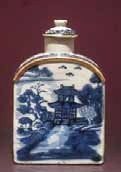
Fig. 1.
Tea Caddies are a vast subject. Manufactured in very diverse materials they, in many collectors’ minds, are seen to epitomise the very best examples of craftsmanship. The finest top quality materials were transformed into a myriad of designs and it is only possible to scratch the surface in an article of this length. I have picked out below what I consider to be an interesting cross section of styles which are all highly collectible.
Early Georgian Mahogany Caddies
The earlier caddies were more substantial and made of quality mahogany, rectangular in shape with locking lids and standing on bracket feet.
Inside were two or three sections with fitted metal containers made from tin, pewter, brass or sometimes silver. Often they had sliding “secret” panels on one side in which the silver caddy spoon was hidden. Sadly, these days, the containers are usually missing, as are the spoons.
Rolled Paper Work Caddies
Georgian ladies needed something to occupy their time and their hands – shooting with the gentlemen was not an option in those days. Carcases for Tea Caddies for this work were made in various shapes, with recessed panels into which a design was fitted made up from coloured and/or gilded papers rolled into tight rolls, cut to length, dipped in glue and put into place (Fig. 2).
The Caddy illustrated is particularly fine, the design on the back (Fig.3) incorporating a Prince of Wales motif. The colours are unusually bright for a Caddy of this age as, so my family history relates, it was kept in a dark drawer and only shown on special occasions thereby lessening dust damage. The internal lid is not fixed, allowing it to drop with the tea level, keeping it fresh. Mother of Pearl was used as a veneer for a small range of very pretty caddies (Fig. 4)
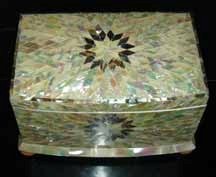
Fig.4.
Tortoiseshell Caddies
More usually 19th Century, these caddies are veneered with the shell of the Hawksbill Sea Turtle from the warmer waters of the Atlantic, Pacific and Indian Oceans, where coral is to be found. Being extremely flexible (and also capable of being moulded), the shell is glued to a gesso-covered wooden carcase (the gesso covers the wood grain) (Fig. 5).
The caddies are then additionally decorated using strips of ivory, brass, silver and mother of pearl. Most incorporate a hanged ring made of silver on the top. Some caddies are further decorated with moulded tortoiseshell in the form of knops and mouldings around the edges as used for wooden caddies. (Fig. 6) The majority of caddies are mottled brown in colour; others, which can be more valuable, are coloured green or red. (Fig. 7) They usually stand on brass or silver feet. These caddies are highly desirable and command high prices.
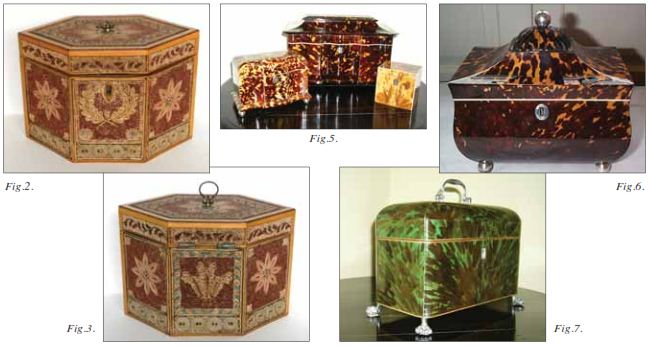
Ivory Caddies
The finest examples of Ivory Caddies (Fig. 8) date from the 1770s to Regency times. They tend to be single compartment containers and octagonal (or sometimes decagonal) in shape. The veneers of ivory are usually separated by silver or pewter strips. Delicately wrought silver handles (sometimes known as Dutch drops) are placed on the lid. Caddies of this period were commonly lined with a tin lead alloy called “tea pewter”. Internal lids were often unfixed so that they dropped onto the tea surface to keep it fresher.
In the opinion of many collectors, Ivory Caddies are the most desirable (and therefore expensive!). Needless to say fakes abound! I once bought a ‘Georgian’ caddy at some considerable price which was then discovered to be a fake made up from ivory piano keys!
Caddies mainly made of Wood
Mahogany, Walnut, Satinwood and Rosewood were mainly used for the basic carcase. Whilst there are a lot of plain designs with different mouldings, vast numbers were embellished with boxwood and ebony stringing (some in complex designs), kingwood and many other cross-bandings. The octagonal late Georgian satinwood caddy (Fig. 9) is fairly plain on its vertical surfaces but beautifully inlaid on its top (Fig 10).
Larger Tea Caddies were made throughout the 19th Century, incorporating two lidded smaller caddies positioned either side of a fine cut glass bowl. Opinions vary about the use of this bowl; some say it was used for mixing the two different teas (green and black); others say it was a sugar bowl (which I go with). The jury is out! Another fine example of late 18th/early 19th Century craftsmanship is the oval caddy; this satinwood one is beautifully inlaid with flowers and leaves and the margins, top and bottom, cross-banded with tulipwood. Fig. 11)
Extremely rare are tea caddies made to represent fruits. The two below (Fig. 12 and 13), an apple and a pear, are probably the most common. These types of caddy command high prices and are highly collectible.
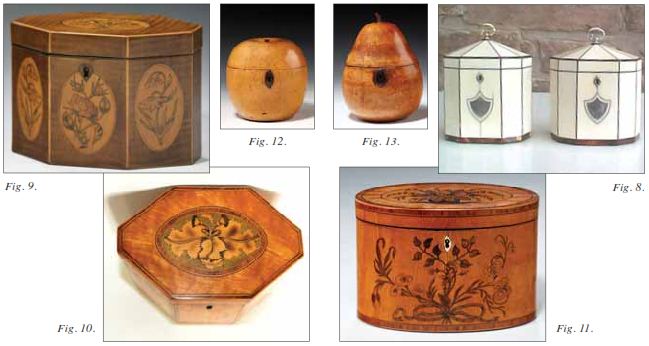
Whilst Tunbridgeware (originating in Tonbridge, Kent) has been made from the 17th Century, the development of mosaic work from the 1830s (coincident with similar work from Italy called Sorrento) turned into a massive area for collecting and encompassed articles of every description. The Tea Caddy pictured is a fine example of the work.
Two more unusual caddies which perhaps indicate what a vast subject this is, the surface of which I have tried to scratch. They epitomise the range of creativity in an attempt to attract extremes in a particular market. Both caddies are very decorative and have very similar values.
The pictures used above have come from various sources including my own collection. I am very grateful to Barbara and Peter Lang of Coromandel Antique Restoration, West Sussex who have provided photos of ivory, tortoiseshell and mother of pearl caddies they have restored so beautifully. Visit their website to see more of their work at www.antiquesboxes.com or call them on 01798-813716 to discuss similar restoration.
Simon Foord
Simon Foord is an antique dealer and furniture restorer. He is also an antiques valuer. He lives in the Stour Valley.
